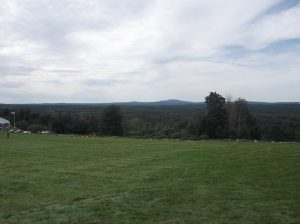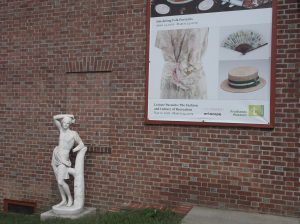The book we chose for Book Club this month took place largely at the New England Aquarium, so I decided to drive to Boston today and pay them a visit. I took the Green Line from Riverside to Government Center and then changed to the Blue Line, and in minutes, I got out at Aquarium. It was cloudy and chilly today, but perhaps only in comparison to the heat waves we experienced this past summer, and the waterfront was bustling.
Here’s what you see when you first walk in: the bottom of the four-story Giant Ocean Tank, which features a coral reef, an underwater communications system, large windows, and hundreds of Caribbean reef animals,

The Aquarium website says about the GOT:
It is 40 feet wide and holds 200,000 gallons of salt water. The water is heated to between 72° and 75° F, which is a perfect temperature range for this tropical exhibit. This exhibit is so big that it was built first, and then the rest of the Aquarium was built around it.
From the climbing ramp, I photographed this impressive whale skeleton. Balaenoptera musculus, the blue whale, is the largest animal ever known to have lived on our planet.

At the Edge of the Sea tidepool tank, visitors may touch the animals, such as these sea stars:

You wouldn’t want to touch this spiny sea urchin:

I tried to capture the lacy beauty of this Atlantic Coast denizen:

The shapes and colors of reef species are almost other worldly:

Everyone loves Myrtle, the green sea turtle. Myrtle has lived at the Aquarium in the Giant Ocean Tank for almost forty years. She is approximately 80 years old, weighs more than 500 pounds, and eats lettuce, cabbage, squid, and Brussels sprouts.

Everyone loves the penguins too! The Aquarium is home to more than 80 penguins; species represented include African penguins, rock hopper penguins, and little blue penguins.

The Aquarium accepts rescued seals for their exhibits. Here is a seal swimming happily around in the New Balance Foundation Marine Mammal Center.

The smaller tanks host specialized communities; here’s a colorful tropical fish:

Many fish really are dangerous. This lionfish has venomous spines which protect it from most predators. Lionfish are native to the tropical Pacific and Indian Oceans, which means they are invasives here in the Atlantic Ocean.

Coral reefs are fantastically diverse communities and also highly endangered due to a number of factors including climate change.

The Aquarium does have a Giant Pacific Octopus, which I saw but could not get a good photo of. I didn’t see it eat or change colors, but it was a popular exhibit and I didn’t want to linger too long in front of it. This octopus lives in the Olympic Coast exhibit, which emphasizes the importance of the Olympic Coast National Marine Sanctuary, a 135 mile stretch of shoreline along Washington State, continuing seaward as far as the continental shelf and home to a large variety of sea birds, marine mammals, fishes, and invertebrates.
I should have spent more time here, but I did become a member, which means I can go back and visit any time, without needing to purchase a ticket. Perhaps in the dead of winter, I’ll long for tropical seas and will make my way back here to Boston’s Central Wharf.









